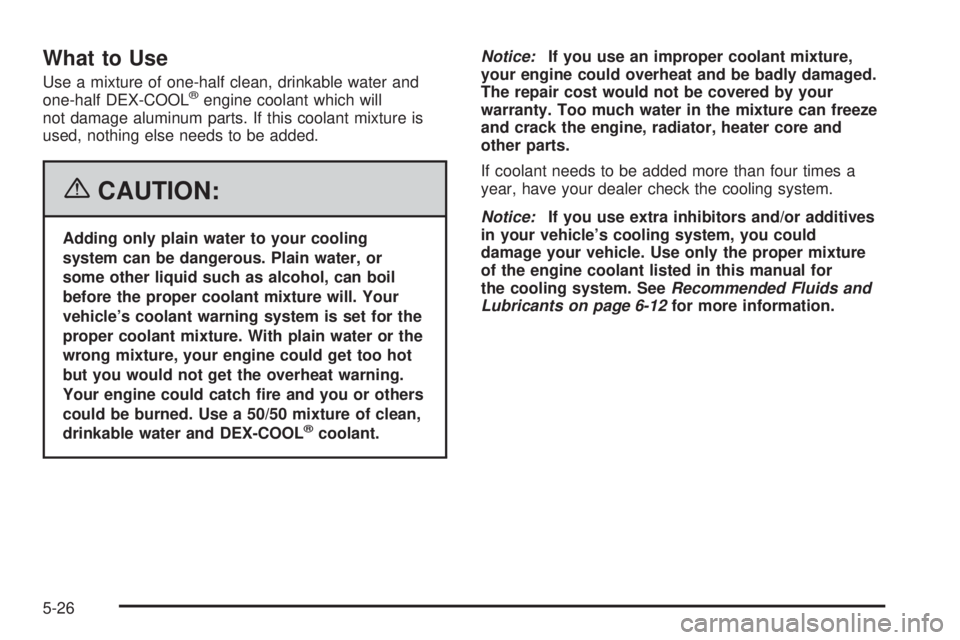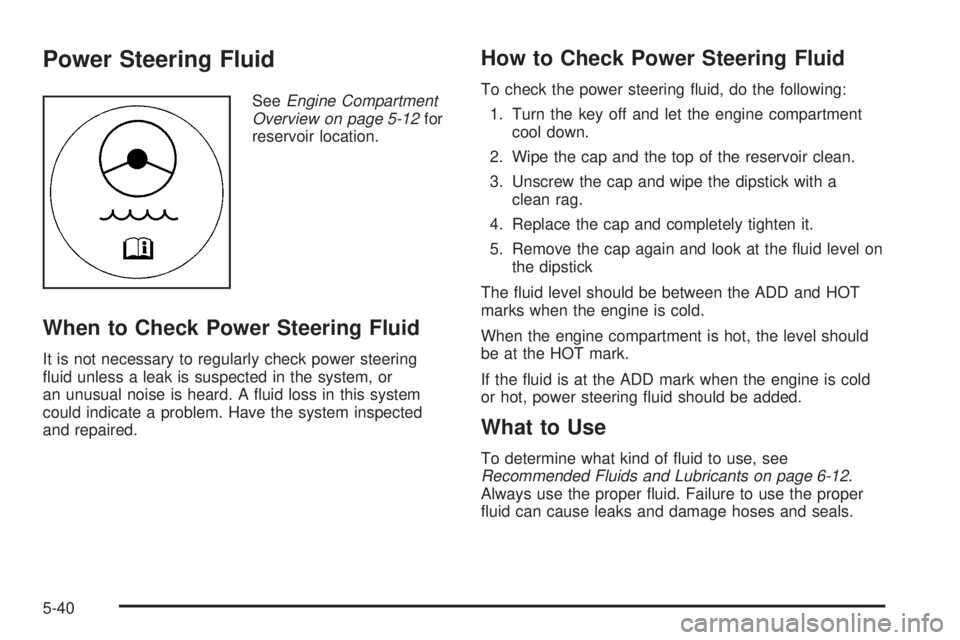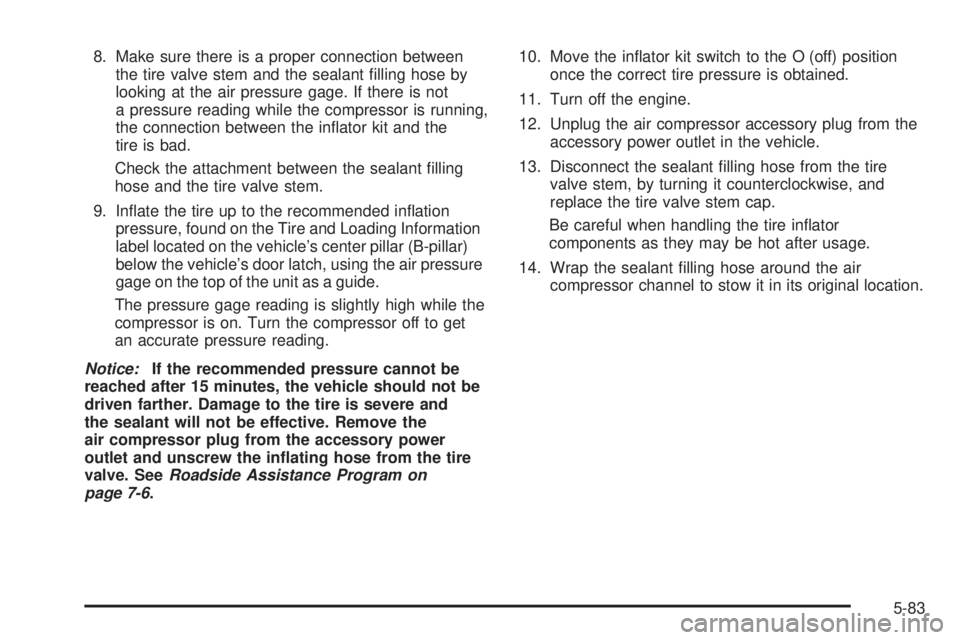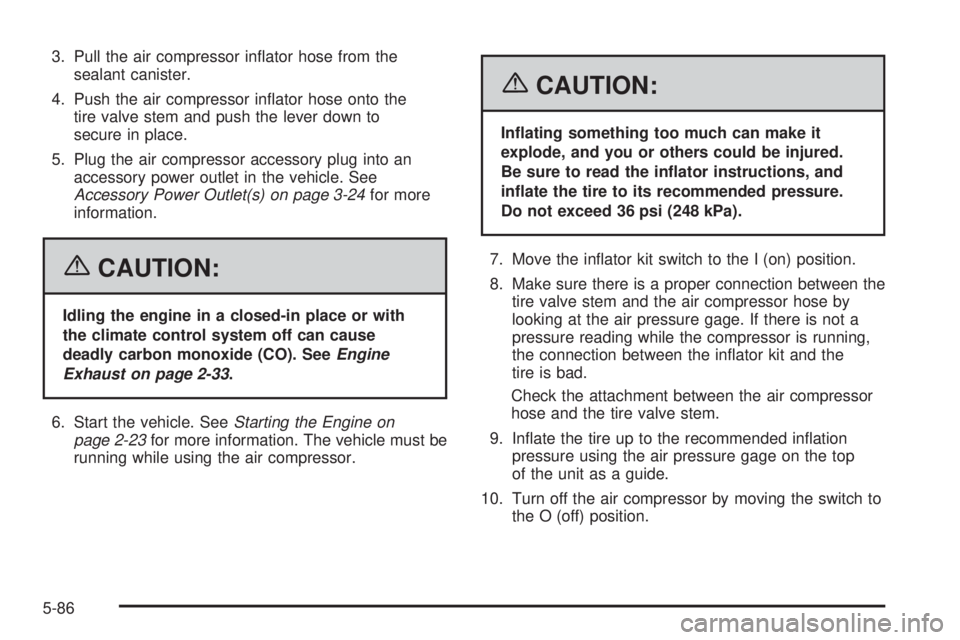2006 PONTIAC GRAND PRIX check engine
[x] Cancel search: check enginePage 332 of 472

What to Use
Use a mixture of one-half clean, drinkable water and
one-half DEX-COOL®engine coolant which will
not damage aluminum parts. If this coolant mixture is
used, nothing else needs to be added.
{CAUTION:
Adding only plain water to your cooling
system can be dangerous. Plain water, or
some other liquid such as alcohol, can boil
before the proper coolant mixture will. Your
vehicle’s coolant warning system is set for the
proper coolant mixture. With plain water or the
wrong mixture, your engine could get too hot
but you would not get the overheat warning.
Your engine could catch �re and you or others
could be burned. Use a 50/50 mixture of clean,
drinkable water and DEX-COOL
®coolant.Notice:If you use an improper coolant mixture,
your engine could overheat and be badly damaged.
The repair cost would not be covered by your
warranty. Too much water in the mixture can freeze
and crack the engine, radiator, heater core and
other parts.
If coolant needs to be added more than four times a
year, have your dealer check the cooling system.
Notice:If you use extra inhibitors and/or additives
in your vehicle’s cooling system, you could
damage your vehicle. Use only the proper mixture
of the engine coolant listed in this manual for
the cooling system. SeeRecommended Fluids and
Lubricants on page 6-12for more information.
5-26
Page 333 of 472

Checking Coolant
The coolant recovery tank
cap has this symbol on it.
SeeEngine Compartment Overview on page 5-12
for more information on the location of the coolant
recovery tank.
The vehicle must be on a level surface when checking
the coolant level.
When the engine is cold, the coolant level should be at
the cold �ll line or a little higher. The cold �ll line is
marked with the same symbol as the coolant recovery
tank cap.
Adding Coolant
If more coolant is needed, add the proper DEX-COOL®
coolant mixture at the coolant recovery tank, but be
careful not to spill it.If the coolant recovery tank is completely empty, add
coolant to the radiator. SeeEngine Overheating
on page 5-28.
{CAUTION:
Turning the pressure cap when the engine and
radiator are hot can allow steam and scalding
liquids to blow out and burn you badly. With the
coolant recovery tank, you will almost never
have to add coolant at the radiator. Never turn
the pressure cap — even a little — when the
engine and radiator are hot.
{CAUTION:
You can be burned if you spill coolant on hot
engine parts. Coolant contains ethylene glycol,
and it will burn if the engine parts are hot
enough. Do not spill coolant on a hot engine.
Occasionally check the coolant level in the radiator. For
information on how to add coolant to the radiator,
seeCooling System on page 5-30.
5-27
Page 338 of 472

When the engine is cold, the coolant level should be at
or above the cold �ll line on the coolant recovery
tank. To check the coolant level, look for the cold �ll line
on the side of the coolant recovery tank that faces the
engine. If the level is not correct, there may be a leak at
the pressure cap or in the radiator hoses, heater
hoses, radiator, water pump, or somewhere else in the
cooling system.
{CAUTION:
Heater and radiator hoses, and other engine
parts, can be very hot. Do not touch them. If
you do, you can be burned.
Do not run the engine if there is a leak. If you
run the engine, it could lose all coolant. That
could cause an engine �re, and you could be
burned. Get any leak �xed before you drive
the vehicle.If there seems to be no leak, with the engine on, check
to see if the electric engine cooling fan(s) are running.
If the engine is overheating, the fan(s) should be
running. If the fan(s) are not running, the vehicle
needs service.
Notice:Engine damage from running your engine
without coolant is not covered by your warranty. See
Overheated Engine Protection Operating Mode on
page 5-30for information on driving to a safe place
in an emergency.
Notice:Using coolant other than DEX-COOL
®may
cause premature engine, heater core or radiator
corrosion. In addition, the engine coolant may
require changing sooner, at 30,000 miles (50 000 km)
or 24 months, whichever occurs �rst. Any repairs
would not be covered by your warranty. Always use
DEX-COOL
®(silicate-free) coolant in your vehicle.
5-32
Page 344 of 472

10. Start the engine and let it run until you can feel the
upper radiator hose getting hot. Watch out for the
engine cooling fan(s).11. By this time, the coolant level inside the radiator
�ller neck may be lower. If the level is lower, add
more of the proper DEX-COOL
®coolant mixture
through the �ller neck until the level reaches
the base of the �ller neck.
12. Then replace the pressure cap. At any time during
this procedure if coolant begins to �ow out of the
�ller neck, reinstall the pressure cap. Be sure
the pressure cap is hand-tight and fully seated.
13. Check the coolant in the recovery tank. The level in
the coolant recovery tank should be at the cold �ll
line when the engine is cold.
3800 V6 Supercharged Engine shown, 3800 V6
Engine similar
5-38
Page 346 of 472

Power Steering Fluid
SeeEngine Compartment
Overview on page 5-12for
reservoir location.
When to Check Power Steering Fluid
It is not necessary to regularly check power steering
�uid unless a leak is suspected in the system, or
an unusual noise is heard. A �uid loss in this system
could indicate a problem. Have the system inspected
and repaired.
How to Check Power Steering Fluid
To check the power steering �uid, do the following:
1. Turn the key off and let the engine compartment
cool down.
2. Wipe the cap and the top of the reservoir clean.
3. Unscrew the cap and wipe the dipstick with a
clean rag.
4. Replace the cap and completely tighten it.
5. Remove the cap again and look at the �uid level on
the dipstick
The �uid level should be between the ADD and HOT
marks when the engine is cold.
When the engine compartment is hot, the level should
be at the HOT mark.
If the �uid is at the ADD mark when the engine is cold
or hot, power steering �uid should be added.
What to Use
To determine what kind of �uid to use, see
Recommended Fluids and Lubricants on page 6-12.
Always use the proper �uid. Failure to use the proper
�uid can cause leaks and damage hoses and seals.
5-40
Page 355 of 472

5. Check that the jumper cables do not have loose or
missing insulation. If they do, you could get a
shock. The vehicles could be damaged too.
Before you connect the cables, here are some
basic things you should know. Positive (+) will go to
positive (+) or to a remote positive (+) terminal if
the vehicle has one. Negative will go to a heavy,
unpainted metal engine part or to a remote
negative (−) terminal if the vehicle has one.
Do not connect positive (+) to negative (−), or you
will get a short that would damage the battery
and maybe other parts too. And do not connect the
negative (−) cable to the negative (−) terminal on
the dead battery because this can cause sparks.
6. Connect the red positive (+) cable to the positive (+)
terminal location on the vehicle with the dead
battery. Use a remote positive (+) terminal if the
vehicle has one.
7. Do not let the other end touch metal. Connect it to
the positive (+) terminal location on the vehicle with
the good battery. Use a remote positive (+)
terminal if the vehicle has one.8. Now connect the black negative (−) cable to the
negative (−) terminal location on the vehicle with
the good battery. Use a remote negative (−) terminal
if the vehicle has one.
Do not let the other end touch anything until the
next step. The other end of the negative (−) cable
does not go to the dead battery. It goes to a
heavy, unpainted metal engine part or to a remote
negative (–) terminal on the vehicle with the
dead battery.
9. Connect the other end of the negative (−) cable at
least 18 inches (45 cm) away from the dead battery,
but not near engine parts that move. The electrical
connection is just as good there, and the chance
of sparks getting back to the battery is much less.
10. Now start the vehicle with the good battery and run
the engine for a while.
11. Try to start the vehicle that had the dead battery.
If it will not start after a few tries, it probably
needs service.
5-49
Page 389 of 472

8. Make sure there is a proper connection between
the tire valve stem and the sealant �lling hose by
looking at the air pressure gage. If there is not
a pressure reading while the compressor is running,
the connection between the in�ator kit and the
tire is bad.
Check the attachment between the sealant �lling
hose and the tire valve stem.
9. In�ate the tire up to the recommended in�ation
pressure, found on the Tire and Loading Information
label located on the vehicle’s center pillar (B-pillar)
below the vehicle’s door latch, using the air pressure
gage on the top of the unit as a guide.
The pressure gage reading is slightly high while the
compressor is on. Turn the compressor off to get
an accurate pressure reading.
Notice:If the recommended pressure cannot be
reached after 15 minutes, the vehicle should not be
driven farther. Damage to the tire is severe and
the sealant will not be effective. Remove the
air compressor plug from the accessory power
outlet and unscrew the in�ating hose from the tire
valve. SeeRoadside Assistance Program on
page 7-6.10. Move the in�ator kit switch to the O (off) position
once the correct tire pressure is obtained.
11. Turn off the engine.
12. Unplug the air compressor accessory plug from the
accessory power outlet in the vehicle.
13. Disconnect the sealant �lling hose from the tire
valve stem, by turning it counterclockwise, and
replace the tire valve stem cap.
Be careful when handling the tire in�ator
components as they may be hot after usage.
14. Wrap the sealant �lling hose around the air
compressor channel to stow it in its original location.
5-83
Page 392 of 472

3. Pull the air compressor in�ator hose from the
sealant canister.
4. Push the air compressor in�ator hose onto the
tire valve stem and push the lever down to
secure in place.
5. Plug the air compressor accessory plug into an
accessory power outlet in the vehicle. See
Accessory Power Outlet(s) on page 3-24for more
information.
{CAUTION:
Idling the engine in a closed-in place or with
the climate control system off can cause
deadly carbon monoxide (CO). SeeEngine
Exhaust on page 2-33.
6. Start the vehicle. SeeStarting the Engine on
page 2-23for more information. The vehicle must be
running while using the air compressor.
{CAUTION:
In�ating something too much can make it
explode, and you or others could be injured.
Be sure to read the in�ator instructions, and
in�ate the tire to its recommended pressure.
Do not exceed 36 psi (248 kPa).
7. Move the in�ator kit switch to the I (on) position.
8. Make sure there is a proper connection between the
tire valve stem and the air compressor hose by
looking at the air pressure gage. If there is not a
pressure reading while the compressor is running,
the connection between the in�ator kit and the
tire is bad.
Check the attachment between the air compressor
hose and the tire valve stem.
9. In�ate the tire up to the recommended in�ation
pressure using the air pressure gage on the top
of the unit as a guide.
10. Turn off the air compressor by moving the switch to
the O (off) position.
5-86